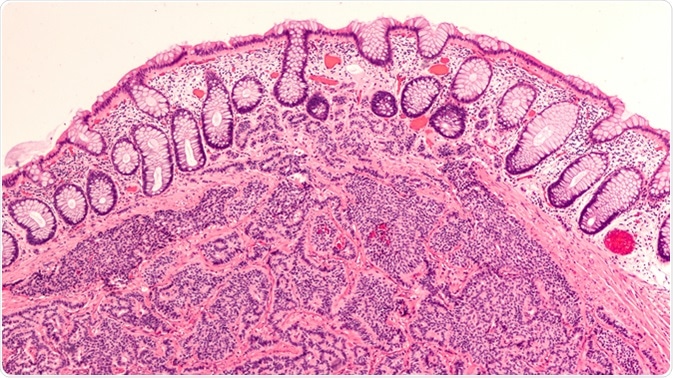Many are unaware of the risk factors of carcinoid tumors of the lung. Through many scientific studies, researchers have found that changes in the lungs, due to dangerous chemicals or radiation, cause carcinoma. However, these components are not considered significant in the increased risk of lung carcinoid tumors.

Photomicrograph of a carcinoid tumor, a type of neuroendocrine tumor (NET), which presented as a colon polyp during routine colonoscopy. Spread to liver can cause symptoms of carcinoid syndrome. Image Credit: David Litman / Shutterstock
Genetic Factor that Cause Carcinoid
The causes for carcinoid tumors are obscure. Genetic factors are thought to be implicated in addition to a myriad of other factors. Anomalies in chromosomes comprise differences such as loss of heterogeneity and numerical imbalances.
- MEN-1 is the abbreviation for multiple endocrine neoplasia type 1 and it is a group of disorders that give rise to neuroendocrine tumors in the parathyroid, pituitary and pancreas. Many carcinoid tumors occur together with MEN 1. Despite the fact that neuroendocrine tumors depend on the site of the MEN 1 gene mutation, the genetic events underlying the neoplastic process are mostly unfamiliar. Genetic cases except those related to MEN 1 are uncommon, but they usually take place.
- Various studies have shown a loss of heterozygosity (LOH) with the MEN1 gene. It has been found that abnormalities related to this gene are connected to chromosome 11. These are a part of or independent of MEN 1. Among the 5 of 9 exemplary carcinoid tumors of the lung, three apparent regions of allelic loss have been diagnosed at bands 11q13.1 (D11S1883), 11q14.3-11q21 (D11S906), and 11q25 (D11S910).
- A few abnormal carcinoids have LOH at band 11q13, between markers PYGM and D11S937, and at bands 11q14.3-11q21 (D11S906), 11q23.2-23.3 (D11S939), and 11q25 (D11S910). The region at band 11q13 with MEN 1 may be more affected in abnormal carcinoid tumors than that in normal carcinoid tumors. Thus, band 11q13 is considered significant among these tumors. Destructive abnormal carcinoid tumors, characterized by high mitosis, vascular invasion and organ metastasis, also seem to possess more allelic losses than other types of tumors.
- Band 11q13 with the MEN 1 gene possibly acts as a tumor-suppressor gene. In the investigation of 46 sporadically occurring tumors, 78% had LOH at this site, with five patients lacking nearly all alleles. The rest had an unbroken pattern in genetic heterozygosity. Some studies have found that inactivation of a tumor-suppressor gene on chromosome 11 and genetic mutations provoking DNA-mismatch repair result in sporadically occurring carcinoid tumors.
Risk Factors Causing Carcinoid
The formation of carcinoid tumors is infrequent. There is not much knowledge about the factors that lead to these tumors, and physicians consider that, in most cases, they occur unexpectedly. A risk factor is that which leads to acquiring a disease. Risk factors depend on the type of cancer. It is not absolute that one or more risk factors will cause cancer. It can be seen that a person with no risk factors may get cancer, whereas a person with many risk factors may not get cancer.
Ethnic background: African descendants are a little more exposed to carcinoids than are people of Caucasian descent.
Gender: In general, relatively more women develop carcinoids than men.
Diabetes: These tumors are more common in long-term diabetic patients.
Other medical conditions: An inflammation in the stomach lining for a long period (called chronic atrophic gastritis) increases the risk in the stomach. The presence of MEN 1 or a syndrome called Zollinger Ellison, a condition where the stomach secretes more acid than usual, creates a higher risk of stomach carcinoid.
Possible risk factors: It is not quite clear whether the risk factors increase the chance of tumors.
Age: The age for examining GI carcinoid tumors is 55–65 and for lung carcinoid tumors, between 45–55. There is less chance of cancers affecting children.
Saturated fats: Some studies suggest that the intake of more saturated fat increases the risk for carcinoid in the small intestine in comparison with intake of low saturated fat. However, more research has to be done in this area.
Smoking and alcohol: These increase one’s chances of developing carcinoids.
Obesity: Unnaturally obese people, having body mass index greater than 35, have twice the risk of cancer in the small intestine in comparison with those of normal weight.
Hormone therapy: This is another risk factor and is believed to be dependent on the type and duration of the therapy.
Physicians have the knowledge that the onset of tumors may be very small and that they gradually increase. The microscopic view of some parts removed from patients indicates small clusters of neuroendocrine cells that look similar to tiny carcinoids. However, scientists are still unclear about the reason why some remain small and some grow to cause signs of illness.
Carcinoid Tumors
Further Reading